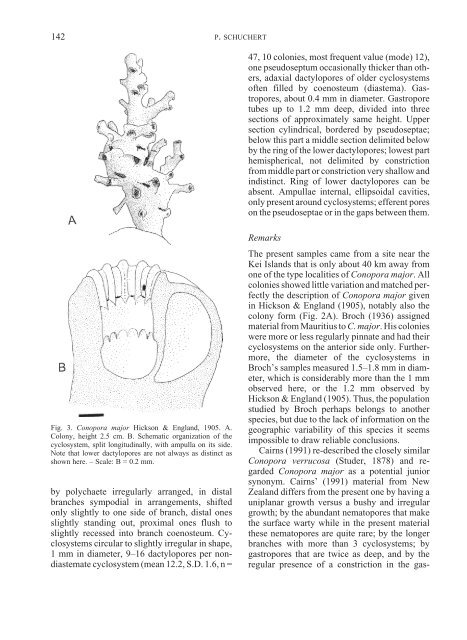Hydroids (Cnidaria, Hydrozoa) of the Danish expedition to
Hydroids (Cnidaria, Hydrozoa) of the Danish expedition to
Hydroids (Cnidaria, Hydrozoa) of the Danish expedition to
You also want an ePaper? Increase the reach of your titles
YUMPU automatically turns print PDFs into web optimized ePapers that Google loves.
142<br />
Fig. 3. Conopora major Hickson & England, 1905. A.<br />
Colony, height 2.5 cm. B. Schematic organization <strong>of</strong> <strong>the</strong><br />
cyclosystem, split longitudinally, with ampulla on its side.<br />
Note that lower dactylopores are not always as distinct as<br />
shown here. – Scale: B = 0.2 mm.<br />
by polychaete irregularly arranged, in distal<br />
branches sympodial in arrangements, shifted<br />
only slightly <strong>to</strong> one side <strong>of</strong> branch, distal ones<br />
slightly standing out, proximal ones flush <strong>to</strong><br />
slightly recessed in<strong>to</strong> branch coenosteum. Cyclosystems<br />
circular <strong>to</strong> slightly irregular in shape,<br />
1 mm in diameter, 9–16 dactylopores per nondiastemate<br />
cyclosystem (mean 12.2, S.D. 1.6, n =<br />
P. SCHUCHERT<br />
47, 10 colonies, most frequent value (mode) 12),<br />
one pseudoseptum occasionally thicker than o<strong>the</strong>rs,<br />
adaxial dactylopores <strong>of</strong> older cyclosystems<br />
<strong>of</strong>ten filled by coenosteum (diastema). Gastropores,<br />
about 0.4 mm in diameter. Gastropore<br />
tubes up <strong>to</strong> 1.2 mm deep, divided in<strong>to</strong> three<br />
sections <strong>of</strong> approximately same height. Upper<br />
section cylindrical, bordered by pseudoseptae;<br />
below this part a middle section delimited below<br />
by <strong>the</strong> ring <strong>of</strong> <strong>the</strong> lower dactylopores; lowest part<br />
hemispherical, not delimited by constriction<br />
from middle part or constriction very shallow and<br />
indistinct. Ring <strong>of</strong> lower dactylopores can be<br />
absent. Ampullae internal, ellipsoidal cavities,<br />
only present around cyclosystems; efferent pores<br />
on <strong>the</strong> pseudoseptae or in <strong>the</strong> gaps between <strong>the</strong>m.<br />
Remarks<br />
The present samples came from a site near <strong>the</strong><br />
Kei Islands that is only about 40 km away from<br />
one <strong>of</strong> <strong>the</strong> type localities <strong>of</strong> Conopora major. All<br />
colonies showed little variation and matched perfectly<br />
<strong>the</strong> description <strong>of</strong> Conopora major given<br />
in Hickson & England (1905), notably also <strong>the</strong><br />
colony form (Fig. 2A). Broch (1936) assigned<br />
material from Mauritius <strong>to</strong> C. major. His colonies<br />
were more or less regularly pinnate and had <strong>the</strong>ir<br />
cyclosystems on <strong>the</strong> anterior side only. Fur<strong>the</strong>rmore,<br />
<strong>the</strong> diameter <strong>of</strong> <strong>the</strong> cyclosystems in<br />
Broch’s samples measured 1.5–1.8 mm in diameter,<br />
which is considerably more than <strong>the</strong> 1 mm<br />
observed here, or <strong>the</strong> 1.2 mm observed by<br />
Hickson & England (1905). Thus, <strong>the</strong> population<br />
studied by Broch perhaps belongs <strong>to</strong> ano<strong>the</strong>r<br />
species, but due <strong>to</strong> <strong>the</strong> lack <strong>of</strong> information on <strong>the</strong><br />
geographic variability <strong>of</strong> this species it seems<br />
impossible <strong>to</strong> draw reliable conclusions.<br />
Cairns (1991) re-described <strong>the</strong> closely similar<br />
Conopora verrucosa (Studer, 1878) and regarded<br />
Conopora major as a potential junior<br />
synonym. Cairns’ (1991) material from New<br />
Zealand differs from <strong>the</strong> present one by having a<br />
uniplanar growth versus a bushy and irregular<br />
growth; by <strong>the</strong> abundant nema<strong>to</strong>pores that make<br />
<strong>the</strong> surface warty while in <strong>the</strong> present material<br />
<strong>the</strong>se nema<strong>to</strong>pores are quite rare; by <strong>the</strong> longer<br />
branches with more than 3 cyclosystems; by<br />
gastropores that are twice as deep, and by <strong>the</strong><br />
regular presence <strong>of</strong> a constriction in <strong>the</strong> gas-

















